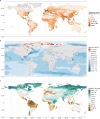The Emerging Global Threat of Salt Contamination of Water Supplies in Tidal Rivers
- PMID: 40822858
- PMCID: PMC12351528
- DOI: 10.1021/acs.estlett.5c00505
The Emerging Global Threat of Salt Contamination of Water Supplies in Tidal Rivers
Abstract
Salt contamination of water supplies in tidal rivers is a global problem, but it has received little attention beyond site-specific studies. Drought, sea-level rise, navigation channel dredging, and watershed land-use change increase the risk of salinization and threaten drinking water supplies, agricultural irrigation, and infrastructure (via corrosion). The emerging issue of salt contamination of water supplies in tidal rivers and its diverse impacts highlight the critical need for interdisciplinary research that must integrate knowledge from oceanography, hydrology, and water resource management. Here we elucidate oceanic and hydrological processes regulating saltwater intrusion into estuaries and tidal rivers as well as watershed processes driving enhanced chemical weathering and export of watershed salts into rivers. By synthesizing studies around the world, we discuss how sea-level rise, prolonged drought, and increasingly extreme weather events in a changing climate are driving more frequent saltwater intrusion events that threaten water security globally. We propose a convergent research agenda toward the development of a decision support tool for salinity management. Specifically we recommend making ion-specific measurements and developing hydrological-hydrodynamic models to simulate the transport of major salt ions. These models can then be combined with artificial intelligence algorithms and enhanced monitoring to explore management strategies with stakeholders.
Keywords: Tidal rivers; climate change; freshwater salinization; saltwater intrusion; water supplies.
© 2025 The Authors. Published by American Chemical Society.
Figures


References
-
- US Army Corps of Engineers . https://www.mvn.usace.army.mil/Media/News-Releases/Article/3544528/usace.... (accessed 2024-11-24).
Publication types
LinkOut - more resources
Full Text Sources
